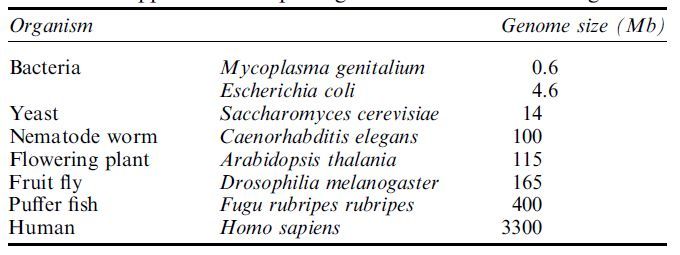


 النبات
النبات
 الحيوان
الحيوان
 الأحياء المجهرية
الأحياء المجهرية
 علم الأمراض
علم الأمراض
 التقانة الإحيائية
التقانة الإحيائية
 التقنية الحيوية المكروبية
التقنية الحيوية المكروبية
 التقنية الحياتية النانوية
التقنية الحياتية النانوية
 علم الأجنة
علم الأجنة
 الأحياء الجزيئي
الأحياء الجزيئي
 علم وظائف الأعضاء
علم وظائف الأعضاء
 الغدد
الغدد
 المضادات الحيوية
المضادات الحيوية|
Read More
Date: 28-11-2015
Date: 7-4-2021
Date: 16-12-2015
|
Eukaryote Genomes
Cellular genomes (i.e. non-viral) vary tremendously in size and complexity. The smallest known from a prokaryote (bacterium) contains about 600 000 DNA base pairs; in contrast, eukaryote genomes such as human and mouse genomes have some 3 billion DNA base pairs (Table ). In eukaryotes, genomic analysis is frequently complicated by their polyploid nature. In humans and the majority of the animal kingdom, including ‘model species’ such as mice and fruit flies, the DNA is packaged into two sets of chromosomes, one set being inherited from each parent. The human diploid genome is organised into 23 pairs of linear chromosomes, one set being inherited from each parent.
All pairs of metaphase chromosomes appear identical in normal karyotypes apart from the sex chromosomes, X and Y, both of which are present in male cells. Sometimes gene pairs differ in their DNA sequences to a small degree and these ‘allelic’ differences can have a marked effect on the expression of the ‘phenotype’. The effects of such allelic differences, which could be as small as the replacement of a single nucleotide within the amino acid coding portion of the gene or in the associated non-coding DNA that regulates gene action, give rise to mendelian genetic phenomena referred to as ‘dominant’, ‘recessive’ or ‘codominant’.
Detecting and characterising the molecular features that differentiate alleles and their expression have remained an important quest for genome scientists and geneticists.
Table : Approximate haploid genome sizes in various organisms




|
|
|
|
التوتر والسرطان.. علماء يحذرون من "صلة خطيرة"
|
|
|
|
|
|
|
مرآة السيارة: مدى دقة عكسها للصورة الصحيحة
|
|
|
|
|
|
|
نحو شراكة وطنية متكاملة.. الأمين العام للعتبة الحسينية يبحث مع وكيل وزارة الخارجية آفاق التعاون المؤسسي
|
|
|